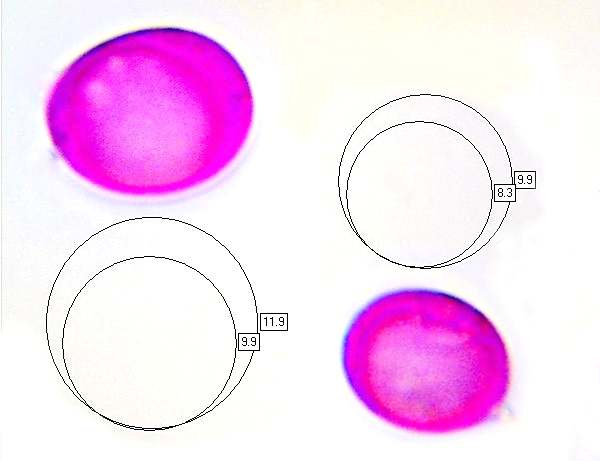Amanita strobiliformis (Paulet ex Vittad.) Bertill. - Warted Amanita
Phylum: Basidiomycota - Class: Agaricomycetes - Order: Agaricales - Family: Amanitaceae
Distribution - Taxonomic History - Etymology - Identification - Culinary Notes - Reference Sources
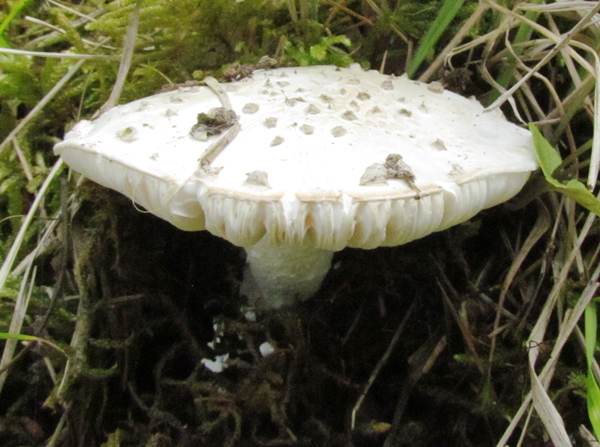
Amanita strobiliformis, often mistaken for Amanita citrina, the False Death Cap, is said by some authorities to be an edible fungus; however, there are reports that it may contain ibonetic acid or muscimol, in which case it is likely to be hallucinogenic if eaten, causing symptoms similar to those resulting from eating Amanita muscaria and Amanita pantherina. In any case great care is necessary because this white Amanita could be confused with the deadly poisonous Destroying Angel, Amanita virosa.
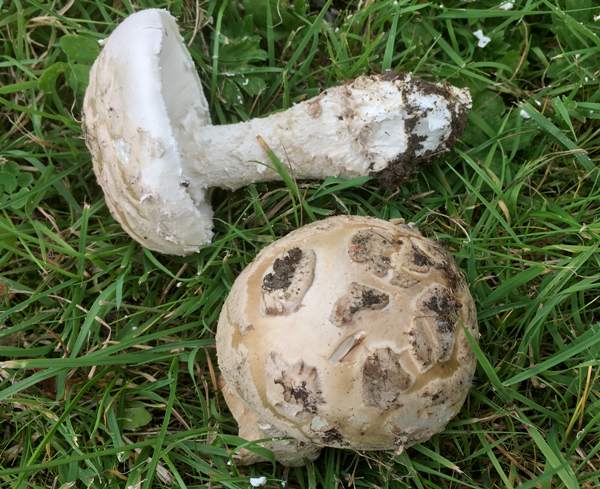
Distribution
Originally described from France but now known in Europe from the Mediterrannean as far north as Britain and the Netherlands, this mushroom favours alkaline soils, and so Beech woodland is one of its main habitats. The Warted Amanita is certainlty a rare find in the UK and far from common in most parts of southern Europe.
For a detailed description of the Amanita genus and identification of common species see our Simple Amanita Key...
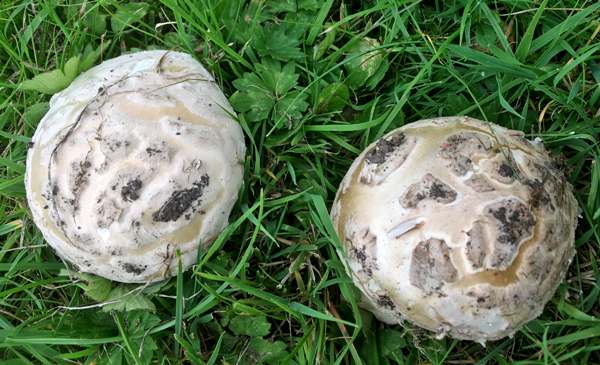
Taxonomic history
This current name of this species dates from an 1866 publication by French mycologist Louis-Adolphe Bertillon (1821 - 1883), who transferred Agaricus strobiliformis Paulet ex Vitadd. to the Amanita genus. Synonyms include Hypophyllum strobiliforme (Paulet ex Vittad.) Paulet, and Agaricus strobiliformis Paulet ex Vittad.
Confusingly, in the past the synonym Amanita solitaria has been applied both to this species and to the quite similar but now generally accepted as a separate species Amanita echinocephala!
Etymology
The specific epithet strobiliformis means shaped like a strobile - in other words cone-like, as in fir cone or the reproductive organs of club mosses, with bract-like projections in a spiral pattern. One of the common names given to this species is 'European Pine Cone Lepidella' (Lepidella being a sub-grouping within the Amanita genus).
Identification guide
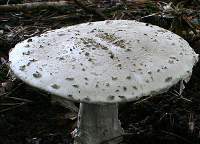 |
Cap5 to 15cm across but exceptionally to 25cm in diameter, brilliant white randomly covered with large creamy-grey veil fragments, which are soft and fluffy at the cap rim. Initially globular, the cap usually remains at least slightly domed even at maturity. |
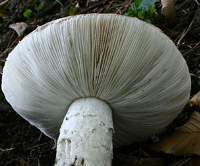 |
GillsWhite, attached (which is unusual for an Amanita mushroom), crowded. |
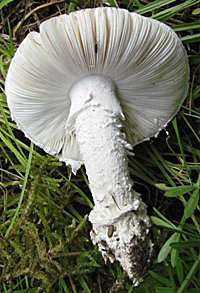 |
StemWhite; 5 - 12cm long and typically 2cm in diameter; covered in warty veil fragments, arising from a slightly bulbous base that is covered in fragments of a collapsed volva. A pendulous thin ring on the upper part of the stem is ephemeral and in mature specimens sometimes disappears without trace. (The ring is still visible on the stem shown here.) |
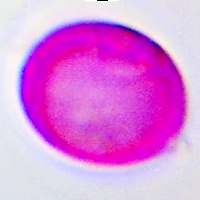 |
SporesSubglobose to elloipsoidal, smooth, 10-13.5 x 7-8.5µm.
Spore printWhite. |
Odour/taste |
When cut or bruised, smelling like cut radishes. Tasting white Amanita species is not advisable because some of them are deadly poisonous. |
Habitat & Ecological role |
Mycorhizal with deciduous trees, usually on alkaline soil. |
Season |
June to November in Britain and Ireland |
Similar species |
Amanita virosa (Destroying Angel) rarely retains veil fragments on its cap through to maturity, the cap remains somewhat domed, its stem-ring is usually high up and not very substantial, and it does not have a sharp smell. Amanita citrina (False Deathcap) occurs in a white variant, but it has flat veil fragments rather than warty ones, and it has a much smoother stem with a distinct persistent ring. |
Culinary Notes
Although some sources suggest that Amanita strobiliformis is an edible species, there are also reports that it may contain the psychoactive chemical compounds ibotenic acid and muscimol that occur in such hallucinogenic species as Amanita muscaria and Amanita pantherina. Many modern field guides warn against collecting Amanita strobiliformis because of the possibility of confusion with deadly poisonous Amanita species, and so my advice is that it should definitely not be gathered for eating.
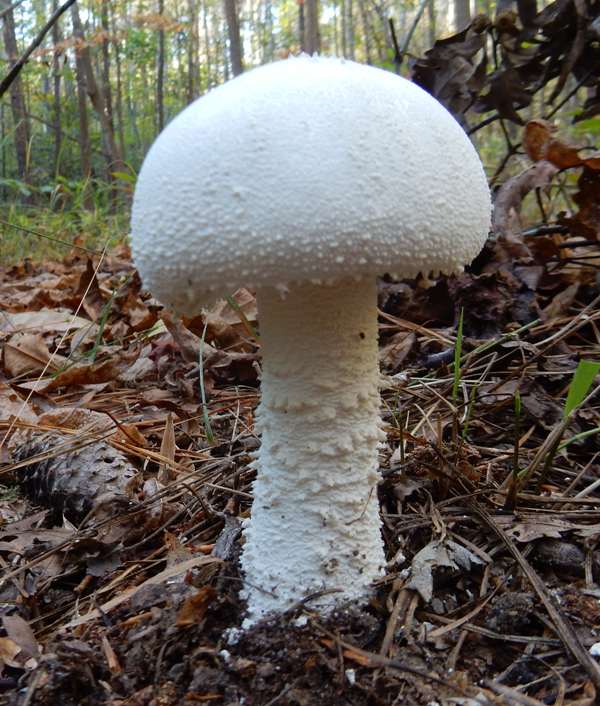
Above: an Amanita strobiliformis lookalike from Virginia USA.
Reference Sources
, Pat O'Reilly, 2016.
Funga Nordica: 2nd edition 2012. Edited by Knudsen, H. & Vesterholt, J. ISBN 9788798396130
BMS List of English Names for Fungi
Geoffrey Kibby, (2012) Genus Amanita in Great Britain, self-published monograph.
Paul M. Kirk, Paul F. Cannon, David W. Minter and J. A. Stalpers (2008). Dictionary of the Fungi; CABI
Taxonomic history and synonym information on these pages is drawn from many sources but in particular from the British Mycological Society's GB Checklist of Fungi.
Acknowledgements
This page includes pictures kindly contributed by Simon Harding and Harold Seelig.
Fascinated by Fungi. Back by popular demand, Pat O'Reilly's best-selling 450-page hardback book is available now. The latest second edition was republished with a sparkling new cover design in September 2022 by Coch-y-Bonddu Books. Full details and copies are available from the publisher's online bookshop...

